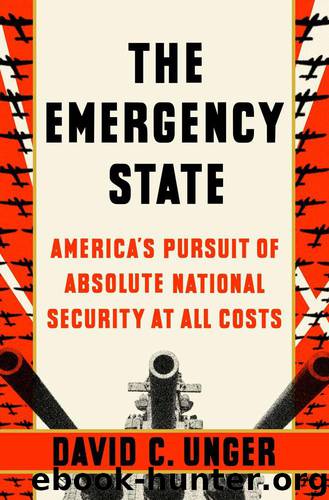The Emergency State: America's Pursuit of Absolute Security at All Costs by Unger David C

Author:Unger, David C. [Unger, David C.]
Language: eng
Format: mobi
Publisher: Penguin Group
Published: 2012-02-15T16:00:00+00:00
Reagan’s military buildup emphasized weapons that were designed to fight, deter, or impress a rival superpower. The Weinberger-Powell Doctrine reserved America’s own military forces for wars of national security necessity, not third-world wars of choice. Yet it was in third-world military struggles—from Afghanistan to Africa to Central America—that Moscow and Washington had been sparring for advantage since Vietnam.
To retake the initiative in these contests, Reagan needed to recruit, fund, supply, and encourage third-world irregulars willing to challenge vulnerable Communist regimes. Washington could not afford to be too picky about which fighters it funded and how closely their political agendas coincided with Washington’s. The CIA-funded Afghan mujahedeen included jihadist recruits from the Arab world who hated godless America as much as they hated godless Russia. Jonas Savimbi’s American-backed UNITA guerrillas joined forces with apartheid South Africa in Angola. And the Nicaraguan Contras, whom Reagan lauded as freedom fighters, were trained by the freedom-crushing armed forces of Argentina’s dirty war junta.
Unlike Eisenhower in Guatemala, Kennedy at the Bay of Pigs, or Carter and Brzezinski during the early stages of the Afghan war, Reagan very much wanted the fact of American support for these anti-Communist armies to be publicly known, if not all the messy details of whom the American money went to and exactly what they used it for. This public support for anti-Communist insurgencies was the essence of the Reagan Doctrine.
Inevitably, however, carrying out the doctrine meant delegating broad power to emergency state agencies like the CIA. Reagan put his former campaign manager, William Casey, in charge of the agency. Casey had run secret intelligence operations out of London for the OSS during World War II. He had gone on to serve as associate general counsel for the Marshall Plan, and then made a fortune on Wall Street. Turning his attention to Republican politics and fund-raising, he served in economic posts during the Nixon administration and then gravitated toward Reagan.
As director of central intelligence, Casey was a throwback to the freewheeling pre-Watergate days of the emergency state. He and his operational deputies operated with little White House restraint. Reagan’s first four national security advisers—Richard Allen, William Clark, Robert “Bud” McFarlane, and John Poindexter—were weak managers and marginal policy players.
Congress had also begun to step back from the oversight role it had insisted on during the 1970s. The Intelligence Reform Act of 1980 had diluted the prior notification requirements of the 1974 Hughes-Ryan Act, licensing the CIA to begin covert operations before congressional oversight committees had been notified. Grants of additional autonomy to the emergency state rarely go unused, and Casey needed little further encouragement.
Under the Reagan Doctrine, funding for third-world anti-Communist fighters could be overt, as for example when Congress approved annual appropriations in the early 1980s for the Nicaraguan Contras. Later the Democratic majority in Congress, including many veterans of the 1970s battles over Indochina, began to have second thoughts about Reagan’s Central America policies.
Democrats had little appetite for challenging Reagan on domestic issues, given the dismal Carter economic record and the post-1982 Reagan boom.
Download
This site does not store any files on its server. We only index and link to content provided by other sites. Please contact the content providers to delete copyright contents if any and email us, we'll remove relevant links or contents immediately.
| Automotive | Engineering |
| Transportation |
Whiskies Galore by Ian Buxton(41880)
Introduction to Aircraft Design (Cambridge Aerospace Series) by John P. Fielding(33064)
Small Unmanned Fixed-wing Aircraft Design by Andrew J. Keane Andras Sobester James P. Scanlan & András Sóbester & James P. Scanlan(32743)
Craft Beer for the Homebrewer by Michael Agnew(18141)
Turbulence by E. J. Noyes(7936)
The Complete Stick Figure Physics Tutorials by Allen Sarah(7307)
Kaplan MCAT General Chemistry Review by Kaplan(6867)
The Thirst by Nesbo Jo(6828)
Bad Blood by John Carreyrou(6552)
Modelling of Convective Heat and Mass Transfer in Rotating Flows by Igor V. Shevchuk(6391)
Learning SQL by Alan Beaulieu(6211)
Weapons of Math Destruction by Cathy O'Neil(6146)
Man-made Catastrophes and Risk Information Concealment by Dmitry Chernov & Didier Sornette(5921)
Digital Minimalism by Cal Newport;(5664)
Life 3.0: Being Human in the Age of Artificial Intelligence by Tegmark Max(5474)
iGen by Jean M. Twenge(5366)
Secrets of Antigravity Propulsion: Tesla, UFOs, and Classified Aerospace Technology by Ph.D. Paul A. Laviolette(5309)
Design of Trajectory Optimization Approach for Space Maneuver Vehicle Skip Entry Problems by Runqi Chai & Al Savvaris & Antonios Tsourdos & Senchun Chai(5011)
Pale Blue Dot by Carl Sagan(4912)
